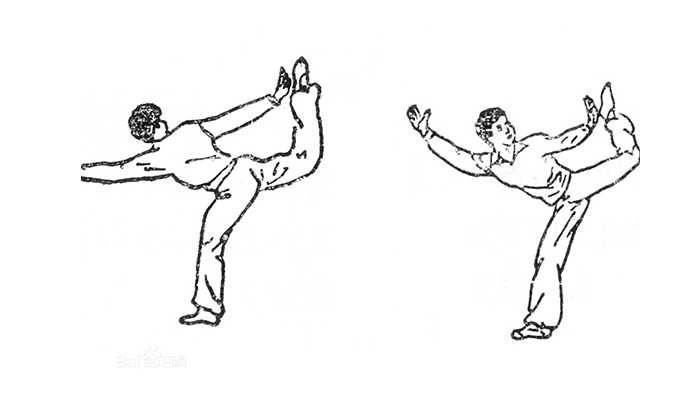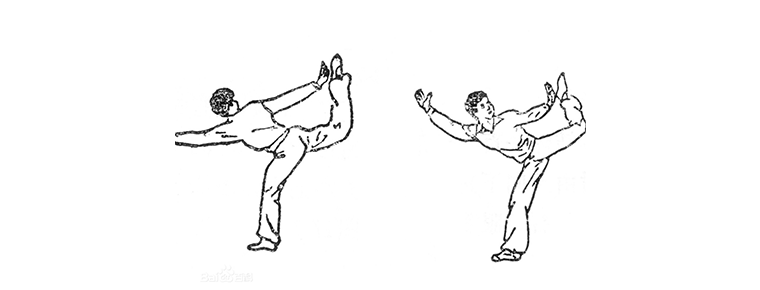Poke feet
Poke feet
Poking feet is one of Chinese boxing. Leg and foot kungfu is the main form. It is said that it originated in the Song Dynasty and flourished in the Ming and Qing Dynasties. The story of Wu Song's drunken beating Jiang Menshen in Chinese folklore tells us that Wu Song used the jade ring step and the Mandarin duck's feet to poke his feet. Therefore, some people still call poking his feet "Shuihumen".
On November 11, 2014, the stamp was approved by the State Council to be included in the fourth batch of national intangible cultural heritage list.
Basic introduction
Punching the foot is a kind of boxing in the north, which is mainly based on leg and foot kungfu. It is said that it originated in the Song Dynasty and is known as "the outstanding person in the North leg". Wu Song beat Jiang Menshen drunkenly. Wu Song used the Yuhuanbu step and the mandarin duck foot. Legend has it that during the Taiping Heavenly Kingdom, Zhao Canyi, a Taiping Army general, was proficient in poking feet and turning boxers. After the defeat of the Taiping Army in Tianjin, Zhao Canyi lived in seclusion in Raoyang, Hebei Province, and handed down poking and turning boxing to the local people. The main legs are kicking, lifting, drifting, dotting and seeing the end. It also emphasizes the skill of both hands and feet. The boxing proverb says, "Hands are two doors, and they hit people with their legs." "Hands hit three points, and feet kick seven points". In the body law, it is required to be correct, flexible, dominant in the waist, and the shoulder and hip of the guest and assistant. From the spine to the foot and from the hip to the hip, they both use the waist gap and shoulder crotch, and often cooperate with the ground movement. There are "eight roots" and "nine branches" in boxing. "Eight roots" multi-lower cross-legged method and "nine branches" multi-upper cross-legged method. One step one leg, one step one foot, a series of kicks, hands and feet.
There are two kinds of trips, one is to poke feet, the other is to poke feet, and the other is to poke feet. The martial arts are flexible, vigorous, long-term, rigid and flexible, mainly rigid. In the comprehensive exercise of hands, eyes, hearts, bodies and steps, the focus is on leg and footwork. The basic leg methods include picking, shearing, dicing, turning, facing the door, inserting and blocking, right and left legs (finger, kicking, turning, point, webbed, wrong, pedaling, rolling, etc.). The traditional Wulu routine is also called "Nine-turn Linked Mandarin Duck Feet", short for "Nine-branch Legs", a total of nine routes, each of which can be exchanged for practice, so it is called "Nine-turn". Each leg method is one step at a time, issued in succession, and the rings are set together, so it is called "Link". Its legs and feet are attacked in succession, left and right sides are exchanged, forming a pair of spouses, so it is called "Mandarin Duck Foot". Wen watches are vigorous and soft, with stitches hidden in them, small and compact, flexible and changeable, close to the shadow, and soft with stiffness. The traditional literary routines are called "Eight Roots" (self-turning feet, Yuhuanbu, stone thunder, archer-like, webbed legs, going out, firecrackers, cross-beating, etc.). Literary routines are lively and rhythmic, and their training methods are mind-to-mind, hand-to-foot; their techniques are push, lift, cotton, turn, paste, Sichuan, entanglement and development; their footwork is forward, backward, flash, swing, pumping, change, channeling, swing; their tactics are one step at a time, unexpected, luring the enemy into depth, then restraining, lower limbs start, half-step wins, like kicking non-kicking, striking in the East and striking in the west. There is also a kind of foot-poking in Northeast China, which is created by Hu Feng-san because of its unique legs and strong fighting ability. With the basic usage of eight roots, eight mothers, eight methods and sixteen formulas and thirty-two characters as the core, the combination of rigidity and softness, short and concise, compact upper body, lower body life, lingering techniques, strong legs, close to combat, flexible and changeable, also known as "Hu's foot poking", Hu's foot poking is mainly "Wen trip", while practicing "Wu trip".
Style and characteristics
To stamp a footnote,
There are two kinds of Wu trips, Wu trips are the origin of poking feet, Wen trips are the development and change of Wu trips. The characteristics of Wu Tuzi are: stretching generously, agility and vigor, long-term striking, rigidity and flexibility, mainly rigidity; it is in the comprehensive exercise of hands, eyes, heart, body and steps, focusing on the exercise of leg and footwork. The basic leg kicking methods include picking, shearing, dicing, turning, blocking in front of the door, right and left legs (fingering, kicking, turning, pointing, webbing, wrong, pedaling, grinding, etc.). The traditional Wulu routine is also called "Nine-turn Linked Mandarin Ducks'Feet". It is abbreviated as "Nine-branch Legs". There are nine routes, each of which can exchange exercises with each other, so it is called "Nine-turn". Each leg method is a step-by-step, continuous, ring-by-ring, so it is called "Link". Its legs and feet are attacked in succession, switching left and right, forming a pair of spouses, thus poking feet.
It is called "mandarin duck foot". Wen watches are vigorous and soft, with stitches hidden in them, small and compact, flexible and changeable, close to the shadow, and soft with stiffness. The traditional literary routines are called "Eight Roots" (self-turning feet, Yuhuanbu, stone thunder, archer-like, webbed legs, going out, firecrackers, cross-beating, etc.). Literary routines are lively and rhythmic, and their training methods are mind-to-mind, hand-to-foot; their techniques are push, lift, cotton, turn, paste, Sichuan, entanglement and development; their footwork is forward, backward, flash, swing, pumping, change, channeling, swing; their tactics are one step at a time, unexpected, luring the enemy into depth, then restraining, lower limbs start, half-step wins, like kicking non-kicking, striking in the East and striking in the west. Pointing feet is good for legs, but it emphasizes the use of hands and feet. The proverb of boxing says, "The hand is two doors, and it hits people by the leg", "The hand hits three points, the foot kicks seven points". It also says, "If the upper limb is not enough, the legs are not good", "If the hand does not reach the leg, it is pure nonsense". Pointing feet in the body law requires centrality, flexibility, dominant in the waist, Binfu shoulder crotch. Start from the spine, start from the buttocks, both of them with waist gap shoulder crotch, that is, the so-called "art preparation method is high, skill to invisible first surprise". After the founding of the People's Republic of China, foot poking was listed as a national Wushu performance and competition item.
historical origin
It is a northern boxing. According to legend, Zhao Yican, the Taiping Army general, left the fist in Raoyang, Hebei Province, when he lived in seclusion. Punching feet is a kind of boxing which is gradually enriched and perfected on the basis of eight diamond frames, eight diamond beats and "Yuhuanbu" techniques. Because they are good at legs, they are praised as the "outstanding northern legs" by later generations.
The full name of "Jiufan imperial step mandarin ducks hang in a series of suspended poking feet". This fist is penny-for-penny and martial arts trip. Its routine changes are evolved from eight basic potentials. "Jiufan" means that there are nine ways for Wen and Wu to travel, and "imperial step" is a typical footwork for poking feet, while "hooking up and linking up" means that all forces are attacked or defended, linked and connected. Pointing feet often take false steps to stand, move hand and foot together, and force feet hanging, so it is known as "suspension", and when attacking, left and right exchange, into a pair of spouses and alias "duck feet". Later generations took "martial Arts trip" as leg work, and took turning boxing as the main body to melt into a furnace and formed "poking foot turning over".
Distribution: Mainly spread in Hebei, Tianjin, Beijing, Northeast China and other places, there are also practitioners in the south.


-
1.Henan Mayuxing Barrel Chicken
Henan Mayuxing Barrel Chicken is a famous specialty dish in Kaifeng. It is famous for its bright yellow color, salty fragrance, tender crisp, fat but not greasy
Time 2018-11-25 -
2.Enshi Grand Canyon
Enshi Grand Canyon is located in Tunpu Township and Banqiao Township, Enshi City, Hubei Province. It is located at the junction of Hunan, Chongqing and Hubei provinces. It is the most beautiful sectio
Time 2018-12-12 -
3.Qianling Scenic Area
Qianling Scenic Area, located in Qianxian County, Xianyang, Shaanxi Province, covers an area of 1002.71 square kilometers. Population: 580,000 (2011), postcode: 713300.
Time 2018-12-22 -
4.China Yellow River Building
The Yellow River Building of China has the Yellow River China History and Culture Exhibition Hall, the Yellow River Ningxia History and Culture Exhibition Hall, the Yellow River Impression Exhibition
Time 2018-12-22 -
5.Gongchangling Hot Spring Skiing Ground
Gongchangling Skiing Ground is located in Tanghe Scenic Area of Gongchangling, Liaoyang City, Liaoning Province. It covers an area of 100 hectares and is a national AAA-class tourist attraction.
Time 2019-01-12 -
6.Tsing Tan Temple
Qingdan Temple is located 3.5 kilometers west of Fucheng, Zaozhuang City, in the narrow valley of Chu and Han Mountains. It was built in the Tang Dynasty.
Time 2019-02-07 -
7.Anshun land Opera
Anshun Dixi Opera, a local traditional drama in Anshun City, Guizhou Province, is one of the national intangible cultural heritage.
Time 2019-04-01 -
8.Wuqiang Wood Engraving New Year Picture
Wuqiang New Year's Painting is one of the traditional folk crafts in Wuqiang County, Hebei Province. It is named for its origin in Wuqiang County, Hebei Province. It is a unique style of Chinese folk
Time 2019-06-30 -
9.Yangxin Tea Picking Opera
In May 2011, Gao'an City, Jiangxi Province, Linchuan District, Fuzhou City, Shaoguan City, Guangdong Province declared that tea-picking operas (Gao'an tea-picking opera, Fuzhou tea-picking opera, nort
Time 2019-07-10 -
10.Bruce Lee
Bruce Lee (November 27, 1940 -1973 July 20th) Lee Jun Fan Teacher Ye Wen Born in California, USA San Francisco The ancestral home of China Guangdong Province Foshan City Shunde District Junan Town The
Time 2019-09-04 -
11.Ba Jin
Ba Jin (November 25, 1904 - October 17, 2005), male, Han nationality , Sichuan Chengdu Man, his ancestral home Zhejiang Jiaxing 。 Ba Jin's original name Li Yao Tang And another pen name, Pei pole, bli
Time 2019-09-06 -
12.Guan Zhong
Guan Zhong (about 723 BC - 645 BC) Ji surname Guan Shi, name Yi Wu, character Zhong, posthumous title, Yingshang (now Yingshang County, Anhui) A famous economist, philosopher, statesman and strategist
Time 2019-09-07